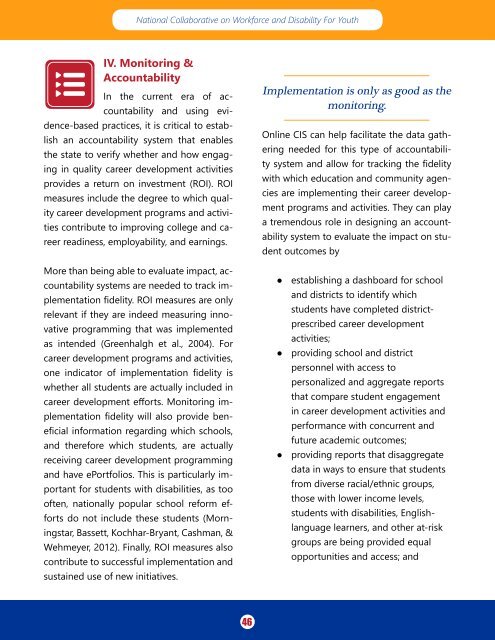Designing Statewide Strategies & Programs
DesigningStatewideCareerDevelopmentStrategiesProgramsPub_0
DesigningStatewideCareerDevelopmentStrategiesProgramsPub_0
You also want an ePaper? Increase the reach of your titles
YUMPU automatically turns print PDFs into web optimized ePapers that Google loves.
National Collaborative on Workforce and Disability For Youth<br />
IV. Monitoring &<br />
Accountability<br />
In the current era of accountability<br />
and using evidence-based<br />
practices, it is critical to establish<br />
an accountability system that enables<br />
the state to verify whether and how engaging<br />
in quality career development activities<br />
provides a return on investment (ROI). ROI<br />
measures include the degree to which quality<br />
career development programs and activities<br />
contribute to improving college and career<br />
readiness, employability, and earnings.<br />
Implementation is only as good as the<br />
monitoring.<br />
Online CIS can help facilitate the data gathering<br />
needed for this type of accountability<br />
system and allow for tracking the fidelity<br />
with which education and community agencies<br />
are implementing their career development<br />
programs and activities. They can play<br />
a tremendous role in designing an accountability<br />
system to evaluate the impact on student<br />
outcomes by<br />
More than being able to evaluate impact, accountability<br />
systems are needed to track implementation<br />
fidelity. ROI measures are only<br />
relevant if they are indeed measuring innovative<br />
programming that was implemented<br />
as intended (Greenhalgh et al., 2004). For<br />
career development programs and activities,<br />
one indicator of implementation fidelity is<br />
whether all students are actually included in<br />
career development efforts. Monitoring implementation<br />
fidelity will also provide beneficial<br />
information regarding which schools,<br />
and therefore which students, are actually<br />
receiving career development programming<br />
and have ePortfolios. This is particularly important<br />
for students with disabilities, as too<br />
often, nationally popular school reform efforts<br />
do not include these students (Morningstar,<br />
Bassett, Kochhar-Bryant, Cashman, &<br />
Wehmeyer, 2012). Finally, ROI measures also<br />
contribute to successful implementation and<br />
sustained use of new initiatives.<br />
●●<br />
●●<br />
●●<br />
establishing a dashboard for school<br />
and districts to identify which<br />
students have completed districtprescribed<br />
career development<br />
activities;<br />
providing school and district<br />
personnel with access to<br />
personalized and aggregate reports<br />
that compare student engagement<br />
in career development activities and<br />
performance with concurrent and<br />
future academic outcomes;<br />
providing reports that disaggregate<br />
data in ways to ensure that students<br />
from diverse racial/ethnic groups,<br />
those with lower income levels,<br />
students with disabilities, Englishlanguage<br />
learners, and other at-risk<br />
groups are being provided equal<br />
opportunities and access; and<br />
46


